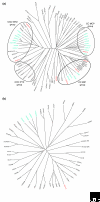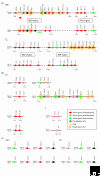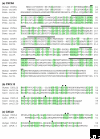The chemokine and chemokine receptor superfamilies and their molecular evolution
- PMID: 17201934
- PMCID: PMC1794421
- DOI: 10.1186/gb-2006-7-12-243
The chemokine and chemokine receptor superfamilies and their molecular evolution
Abstract
The human chemokine superfamily currently includes at least 46 ligands, which bind to 18 functionally signaling G-protein-coupled receptors and two decoy or scavenger receptors. The chemokine ligands probably comprise one of the first completely known molecular superfamilies. The genomic organization of the chemokine ligand genes and a comparison of their sequences between species shows that tandem gene duplication has taken place independently in the mouse and human lineages of some chemokine families. This means that care needs to be taken when extrapolating experimental results on some chemokines from mouse to human.
Figures




References
-
- Yoshie O, Imai T, Nomiyama H. Chemokines in immunity. Adv Immunol. 2001;78:57–110. - PubMed
-
- Pisabarro MT, Leung B, Kwong M, Corpuz R, Frantz GD, Chiang N, Vandlen R, Diehl LJ, Skelton N, Kim HS, et al. Cutting edge: novel human dendritic cell- and monocyte-attracting chemokine-like protein identified by fold recognition methods. J Immunol. 2006;176:2069–2073. - PubMed
Publication types
MeSH terms
Substances
LinkOut - more resources
Full Text Sources
Molecular Biology Databases

